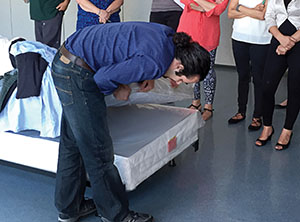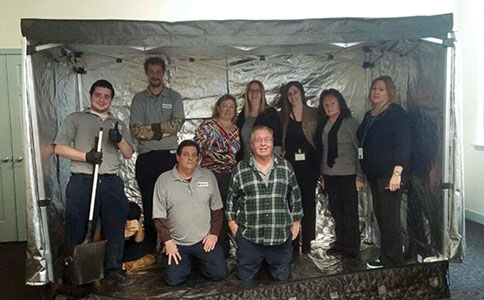To Stop Bed Bugs in Affordable Housing: Keys to Success
 |
|
Entomologist Siavash Taravati demonstrates an inspection for bed bugs. Source: Ana Corbett. |
To stop bed bugs, there’s no one-size-fits-all approach: buildings may gleam, made of concrete and glass with hundreds of units—or brick structures might accommodate just a dozen families. A handful of dedicated staff may carry out maintenance and sanitation tasks daily, or one person may be responsible for everything, on a part-time schedule. One thing every property has in common: managers need to take a proactive approach to pest control, especially for bed bugs.
Affordable housing and low-income communities have been hit hard by the bed bug (Cimex lectularius) resurgence of the last decade. The pests are well-adapted to human environments: we cannot easily apply the traditional integrated pest management (IPM) premise—remove the pest’s food and shelter—to bed bugs. We are their food; meanwhile, they thrive in the cracks and crevices of our homes and furniture. Combine that with problems of bed bug resistance to chemicals, transient populations of humans and their bed bugs, and under-reported infestations, and you have a perfect storm. The good news is that a proactive approach, such as the one promoted by the StopPests in Housing Program at the Northeastern IPM Center, has been shown to reduce the frequency and severity of bed bug infestations. In addition, a proactive approach can eliminate or reduce the need for chemicals.
Below are two examples of success against bed bugs and how property managers achieved it.
Philadelphia, Pennsylvania
 |
|
Property manager Megan and the staff pose in the portable heat chamber used to kill bed bugs in furniture. Source: Megan. |
Megan, a regional property manager of an affordable housing site in Philadelphia, beat the bed bugs after attending an “IPM in Multifamily Housing” training from StopPests in November of 2015. Following the training, and with technical assistance from StopPests throughout the process, she revamped her bed bug protocols, including purchasing a portable heat chamber to treat furniture, wheelchairs, and other hard-to-treat items. Nine months later, she and her team saw a 50 percent reduction in bed bug infestations, going from 31 units being treated to 14. Over two years later, in February of 2018, Megan reports in the 11 buildings her organization oversees, there are zero cases of bed bugs. She attributes her success to having adopted an IPM approach to managing bed bugs, with its plan of proactive inspecting, monitoring, and addressing the education needs of her residents.
Lessons learned: 1) Aggressively inspect and monitor facilities, and educate residents. 2) Update service contracts to reflect IPM methods and best practices for bed bugs.
Southern Illinois
In 2014, the director of a small county housing authority in Illinois had 20 units with bed bug infestations in one of their 107-unit high rises. Working with StopPests, he discovered the heating system pipes were a conduit for bed bugs and other insect pests to travel through the walls and move to other apartments. Maintenance staff then put in days of work sealing each and every unit in the building. By July of 2016 they reported that according to their last building-wide inspection they had only two units with a low-level bed bug infestations. The director attributed their success to a thorough pest control technician, and resident and staff education. Exclusion made the biggest difference, however, backing up research by Richard Cooper and Changlu Wang of Rutgers University. Even when a food source is present, bed bugs are likely to spread to neighboring rooms, apartments, or across the hall.
Lessons learned: Bed bugs travel among units. Exclusion works!
Cooper and Wang point out that we cannot always rely on residents to report bed bug infestations. In fact, in a 2015 study, out of 358 units inspected, 55 were found to be infested, but management was not aware of 71 percent of the infestations in those 55 units. Waiting for residents to report problems is reactive, not proactive. Significant numbers of people don’t react to bites or report infestations.
Proactive inspections two to four times a year and monitoring are important to gain and maintain control of bed bugs. Having a written policy on bed bugs and IPM in general can help maintain practices despite changes in personnel. Complete elimination of bed bugs may not be possible due to constant re-introductions, but these two examples illustrate that proactive management can reduce or eliminate numbers and severity of pest infestations.
References
Cooper, R., C. Wang, and N. Singh. 2015. Evaluation of a model community-wide bed bug management program in affordable housing (272k PDF). Pest Management Science 71. DOI: 10.1002/ps.3982.
Cooper, R., C. Wang, and N. Singh. 2015. Mark-release-recapture reveals extensive movement of bed bugs (Cimex lectularius L.) within and between apartments. PLOS One 10(9): e0136462.
Wang, C., N. Singh, C. Zha, and R. Cooper. 2016. Bed bugs: prevalence in low-income communities, resident’s reactions, and implementation of a low-cost inspection protocol. Journal of Medical Entomology. DOI: 10.1093/jme/tjw018.
— by SUSANNAH REESE and CHRIS GONZALES
The Northeastern IPM Center promotes integrated pest management for reducing risks to human health and the environment. If republishing our news, please acknowledge the source (“From Northeast IPM Insights”) along with a link to our website.
